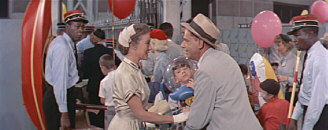 Time to debunk some corporate misinformation! To promote their “Diamond Collection” set of Marilyn Monroe DVDs, Fox sent out promotional postcards. I got one card apiece for the package’s five movies, and each one included some trivia tidbits about the legendary star. On the mailing for 1955’s The Seven Year Itch, we’re told that Marilyn was the inspiration for the visual design of Tinkerbell in Disney’s animated version of Peter Pan.
Time to debunk some corporate misinformation! To promote their “Diamond Collection” set of Marilyn Monroe DVDs, Fox sent out promotional postcards. I got one card apiece for the package’s five movies, and each one included some trivia tidbits about the legendary star. On the mailing for 1955’s The Seven Year Itch, we’re told that Marilyn was the inspiration for the visual design of Tinkerbell in Disney’s animated version of Peter Pan.
This story has received a lot of press over the years, and it’s a terrific tale except for one small problem: it’s not true. According to John Grant’s splendid book Encyclopedia of Walt Disney’s Animated Characters, Tink was actually modeled after an actress named Margaret Kerry. Simple logic would also indicate that Marilyn would not have been an influence behind the character’s design. Peter Pan hit screens in 1953, which was the same year during which Monroe first hit it big. While she’d appeared in films prior to that, none of them had much of an impact, and since animated movies require many years of lead-time before their release, it seems unlikely that the artists would have seen this obscure actress and said “There’s our Tink!” The legend assumes that when the animators designed Tinkerbell, Marilyn was already a star, but that clearly could not have been the case; had Peter Pan hit screens a few years later, then it becomes more possible, but under the circumstances, it seems extremely unlikely.
Miraculously, I was able to put my patented form of righteous indignation behind me as I watched The Seven Year Itch and tried to enjoy the movie. Since Itch was actually a pretty good flick, that wasn’t terribly difficult. While I didn’t think it was a gem, I found Itch to be one of the better Monroe films of the few I’ve seen.
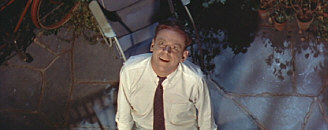 Ironically, though Marilyn got lead billing, she really played more of a supporting character in Itch. The film’s sole main role was that of Richard Sherman (Tom Ewell), a rumpled middle-aged who works at a book publishing company. It’s up to Sherman to spice up book covers to make them more saleable. As such, a reissue of Little Women becomes subtitled “The Secrets Of A Girl’s Dormitory” and features sexy drawings of babes in nighties.
Ironically, though Marilyn got lead billing, she really played more of a supporting character in Itch. The film’s sole main role was that of Richard Sherman (Tom Ewell), a rumpled middle-aged who works at a book publishing company. It’s up to Sherman to spice up book covers to make them more saleable. As such, a reissue of Little Women becomes subtitled “The Secrets Of A Girl’s Dormitory” and features sexy drawings of babes in nighties.
As the movie explains, Manhattan gets horribly hot in the summer, so traditionally wives and kids have packed up and left town for those months while their men remain to work. The husbands don’t seem to mind this, as they become “summer bachelors” and sow their wild oats while the little woman’s gone. Sherman seems determined to avoid this trap, as he steadfastly vows to avoid any of his preferred vices: women, booze, and cigarettes.
Sherman largely succeeds, though he makes himself into a nervous wreck. However, all resistance becomes futile when he espies his new neighbor. This unnamed babe (Monroe) sublets the apartment above Sherman’s, and he quickly falls for her. Despite his conscience, he lets his id get the best of him and he pursues The Girl’s charms, although he remains tortured throughout the experience.
And so it goes. Itch is what some would call a “sex farce”, in that the emphasis is definitely comedic and it also features an adult bent. Although much of the material was probably pretty risqué for the era, it generally seems tame today. Still, it’s not a film that would be appropriate for kids. While nothing in it would be particularly offensive, I can’t see the point of showing it to a little one, as I doubt many would find anything of interest to them.
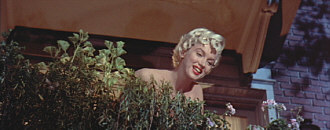 Does it fare better for adults? Definitely. Itch shows its age due to its very “Fifties” view of the sexes. The movie borders on political incorrectness but its riskier moments stay too tame to offer any real offense. Even the film’s iconic moment - when Marilyn allows rising air to life her dress - seems less than titillating.
Does it fare better for adults? Definitely. Itch shows its age due to its very “Fifties” view of the sexes. The movie borders on political incorrectness but its riskier moments stay too tame to offer any real offense. Even the film’s iconic moment - when Marilyn allows rising air to life her dress - seems less than titillating.
Nonetheless, Itch does provide a pretty entertaining experience. The film was adapted from a stage play, and those roots show; I didn’t know this fact until after I’d watched the movie, but based on the style of the production, I’d already guessed that this was the case. Itch expands its horizons slightly, but it mainly sticks with interiors. Most of the picture takes place inside Sherman’s apartment, and almost all of the other shots occur indoors as well; whether at his office or in a health food restaurant, the emphasis remains on interiors.
Sometimes I find the evidence of stage origins to be annoying, as many adaptations do little to make themselves different from the original. When I watched a film such as A Raisin In the Sun, I thought that it seemed so similar to a stage production that I wasn’t sure why they bothered to adapt it; why not just shoot the play itself? Itch doesn’t suffer from that level of literal quality, but the theatrical links remain obvious.
Still, Itch was a generally fun and fluffy flick. As with most of Marilyn’s movies, it’s a bit of a trifle, the kind of film that you watch and enjoy but that doesn’t really stick with you, but that’s not a terrible thing. Light, escapist entertainment is fine with me, and Itch offers a witty and enjoyable way to spend a couple of hours.
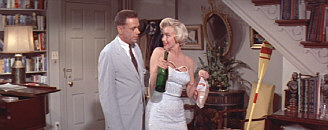 Ewell originated the role of Sherman on stage, and he brings the part to life nicely on screen as well. The character could easily have become annoying; Sherman seems God-awful neurotic at times, and since he remains onscreen throughout virtually the entire film, this might have dragged down the piece as a whole. Happily, Ewell skirts with irritating quirks but doesn’t quite embrace them, and the role remains largely compelling. I wouldn’t quite call Sherman a likeable character, but Ewell at least keeps him from becoming genuinely bothersome, and this was probably as good a balance as one could expect for the part.
Ewell originated the role of Sherman on stage, and he brings the part to life nicely on screen as well. The character could easily have become annoying; Sherman seems God-awful neurotic at times, and since he remains onscreen throughout virtually the entire film, this might have dragged down the piece as a whole. Happily, Ewell skirts with irritating quirks but doesn’t quite embrace them, and the role remains largely compelling. I wouldn’t quite call Sherman a likeable character, but Ewell at least keeps him from becoming genuinely bothersome, and this was probably as good a balance as one could expect for the part.
In regard to Marilyn, well, she plays Marilyn. I’m sure that she worked in films in which her character wasn’t a somewhat bubble-headed, naïve sexpot, but through five of her movies - 1959’s Some Like It Hot and all of the “Diamond Collection” except for Bus Stop - I have yet to see such attempted range. Actually, I suppose Vicky in There’s No Business Like Show Business was smarter and less goofy than the others, but I still don’t think that the role of an ambitious starlet demonstrated much of a stretch from Monroe’s other parts.
While The Girl represents status quo for Marilyn, I must acknowledge that she performs the part well. Some folks seem to think Itch was perhaps her best representation of this sort of role, but frankly, I saw little to differentiate between The Girl and the others she played. The movie itself was a bit brighter and wittier than some of its predecessors, but little about it really stood out to me.
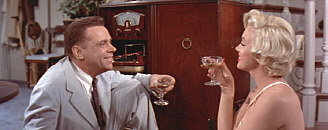 Actually, I have noted one surprising aspect of the movies in which Marilyn acted. I never expected so many inside jokes to appear in the flicks of the Fifties. No, I didn’t think that self-referential qualities were invented with 1996’s Scream, but I still didn’t think there’d be many of these kinds of gags. I was taken aback when 1940’s His Girl Friday made a veiled reference to one of its actors, and that tradition continued at least through 1968’s Rosemary’s Baby, which offered a similar bit. That’s the tactic used during Itch, in which Sherman at one point mentions Marilyn Monroe.
Actually, I have noted one surprising aspect of the movies in which Marilyn acted. I never expected so many inside jokes to appear in the flicks of the Fifties. No, I didn’t think that self-referential qualities were invented with 1996’s Scream, but I still didn’t think there’d be many of these kinds of gags. I was taken aback when 1940’s His Girl Friday made a veiled reference to one of its actors, and that tradition continued at least through 1968’s Rosemary’s Baby, which offered a similar bit. That’s the tactic used during Itch, in which Sherman at one point mentions Marilyn Monroe.
Oddly, I didn’t like the example found in Itch. Usually I think these kinds of comments are a small treat for observant viewers, but this one was too obvious. The difference stems from the level of subtlety. In the cases of His Girl Friday, Rosemary’s Baby or even How to Marry A Millionaire, during which Lauren Bacall makes a reference to “what’s-his-name in African Queen”, the allusions were all somewhat obscure and they rewarded a certain level of knowledge. For example, in the case of Millionaire, the viewer had to know that a) Humphrey Bogart was “what’s-his-name”, and b) Bacall and Bogie were married. Both HGF and RB required that the viewer know that real names of some actors.
In the case of Itch, the reference forces no form of thought or knowledge beyond the most rudimentary. You have to know that Monroe acts in the film, and that’s it. This bit still surprised me, but I thought it was a somewhat witless example of this kind of gag.
Despite that minor misstep, I still found The Seven Year Itch to offer a generally amusing and entertaining experience. It’s not the most clever, incisive or charming comedy to be found, but it does most things well and provides a fairly fun and frisky few hours.
The DVD:
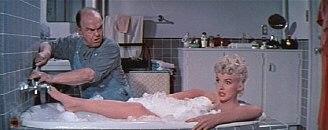 The Seven Year Itch appears in an aspect ratio of approximately 2.55:1 on this single-sided, dual-layered DVD; the image has been enhanced for 16X9 televisions. As with the rest of the movies in the “Diamond Collection”, this one provided a strong viewing experience, with only a few minor concerns along the way.
The Seven Year Itch appears in an aspect ratio of approximately 2.55:1 on this single-sided, dual-layered DVD; the image has been enhanced for 16X9 televisions. As with the rest of the movies in the “Diamond Collection”, this one provided a strong viewing experience, with only a few minor concerns along the way.
Sharpness seemed quite solid throughout the movie. During a few wide interior shots, I thought the picture looked slightly soft, but this was a minor concern. The light fuzziness never approached the more serious levels seen during How to Marry A Millionaire, and it remained largely inconsequential. I saw no problems related to moiré effects, but some jagged edges appeared, mainly via hats. Print flaws were also extremely modest. I witnessed a few examples of speckles, but that was about it; otherwise no forms of grain, scratches, blotches or other concerns caused any issues.
Considering the age of the film, that seemed remarkable, but it becomes even more astonishing when one takes into account the semi-ambitious nature of many shots. Itch has quite a few scenes that use optical effects to integrate one image into another, and given the technology of the time, I fully expected to see lots of print defects in these parts. However, they don’t appear, and though the incorporated segments can look slightly drab, they fail to manifest any overt problems.
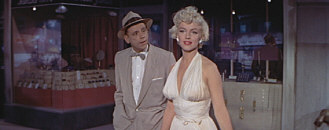 After the vivid hues found in prior Monroe flicks like There’s No Business Like Show Business and Gentlemen Prefer Blondes, the more subdued palette of Itch may come across as a disappointment. While the hues clearly weren’t as eye-popping, I can’t fault the transfer too much for that, as it seemed to accurately replicate the film’s design. Since much of Itch takes place mainly inside purposefully-drab rooms, it would have been a mistake for the colors to appear very bright, so the less-exciting tones seen here looked fine. They remained clear and reasonably solid nonetheless, and I saw no signs of any kinds of bleeding or noise related to them.
After the vivid hues found in prior Monroe flicks like There’s No Business Like Show Business and Gentlemen Prefer Blondes, the more subdued palette of Itch may come across as a disappointment. While the hues clearly weren’t as eye-popping, I can’t fault the transfer too much for that, as it seemed to accurately replicate the film’s design. Since much of Itch takes place mainly inside purposefully-drab rooms, it would have been a mistake for the colors to appear very bright, so the less-exciting tones seen here looked fine. They remained clear and reasonably solid nonetheless, and I saw no signs of any kinds of bleeding or noise related to them.
Black levels appeared similarly deep and rich as well, but shadow detail could be somewhat weak. Itch offered a few low-light sequences, primarily those that took place in Sherman’s bedroom. These didn’t look horribly dark, but I felt that they were a bit too dim and thick. Still, most of my criticisms of the picture of The Seven Year Itch fall into the “nitpicking” category, as the transfer provided a fine image throughout the vast majority of the film.
One minor note: the opening credits of Itch are windowboxed, which means that black bars appear on all four sides of the picture. I guess this was done to make sure that none of the text got cropped by TV overscan. In any case, this technique ends as soon as the credits end.
The Seven Year Itch provided a competent but modest Dolby Digital 3.0 soundtrack. To clarify, a 3.0 mix means that audio comes only from the front right, center and left speakers; basically it’s stereo with specific sound from the middle as well. No surround activity appeared via this track.
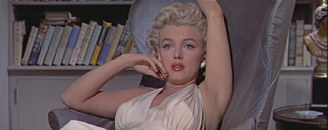 The film’s soundfield remained fairly centralized, but it offered gentle spread to the sides at times. Speech was vaguely localized to the sides, but I didn’t hear the extremely wide imaging encountered during the prior two Monroe films, Millionaire and Show Business. Instead, most of the dialogue either appeared to come from the center or it stretched midway between the middle and the side; very little speech emanated specifically from the far right or left.
The film’s soundfield remained fairly centralized, but it offered gentle spread to the sides at times. Speech was vaguely localized to the sides, but I didn’t hear the extremely wide imaging encountered during the prior two Monroe films, Millionaire and Show Business. Instead, most of the dialogue either appeared to come from the center or it stretched midway between the middle and the side; very little speech emanated specifically from the far right or left.
Music provided moderate stereo imaging, but the various songs also seemed to be generally anchored in the center; Itch definitely lacked the broad spread heard to the tunes of Show Business. Effects tended to go the ambient route, and these provided acceptable usefulness. A few elements did crop up nicely on the sides, however; for example, buzzing doors and ringing telephones both were clearly localized. I thought that the soundfield featured decent stereo imaging for the era, but it wasn’t anything special.
Audio quality appeared fairly good for an older film, but it still showed a few concerns. Most speech sounded reasonably natural and distinct, and I never encountered any problems related to intelligibility. Some modest edginess appeared when lines were spoken loudly; at those times, the words could be a bit rough. Distortion also affected some effects, but not many. Really, only the gunshots that occurred in one scene showed this degradation, as most of the elements seemed acceptably clear and accurate. They remained a minor factor in the film, but they worked fine.
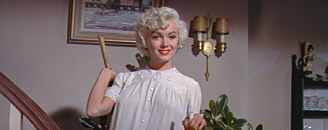 Music fit in neatly with the rest of the audio, and the various songs appeared to be relatively vibrant and dynamic. Highs sounded fairly crisp and clean, and bass response seemed pretty good for a movie from the mid-Fifties; the low-end won’t shake your house, but I thought that the music displayed acceptable depth. Unlike the prior two Monroe flicks, I heard no signs of hiss or other surface flaws to the audio. Ultimately, The Seven Year Itch featured a fairly subdued but solid soundtrack.
Music fit in neatly with the rest of the audio, and the various songs appeared to be relatively vibrant and dynamic. Highs sounded fairly crisp and clean, and bass response seemed pretty good for a movie from the mid-Fifties; the low-end won’t shake your house, but I thought that the music displayed acceptable depth. Unlike the prior two Monroe flicks, I heard no signs of hiss or other surface flaws to the audio. Ultimately, The Seven Year Itch featured a fairly subdued but solid soundtrack.
If one looks over the other four movies in the “Diamond Collection”, one will encounter a decided paucity of supplements. Happily, The Seven Year Itch doesn’t fall into that same category. While it doesn’t exactly go nuts with extras, it still adds some good material.
The main attraction here is a documentary that was part of the American Movie Classics’ “Backstory” series. During this 24-minute and 20-second program, we see a variety of clips from Itch plus lots of great archival photos and footage and recent interviews. In the latter category, we hear from film historian Gerald Gardner, Itch writer George Axelrod, Hugh Hefner, biographer Donald Spoto, Marilyn’s friend James Haspiel, and actor Eli Wallach. In addition, director Billy Wilder appears in some older interview shots.
Although it was a little short, I thought “Backstory” provided an entertaining and informative discussion of the making of Itch. It emphasizes two areas: the censorship problems the crew experienced, and the hubbub that surrounded Marilyn. We get a nice look at both subjects, and I felt that the show adequately covered its subject. I especially enjoyed a quick peek at Walter Matthau’s screen test for the film.
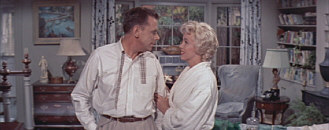 “Backstory” also included two short “Deleted Scenes”, both of which appear in that section of the DVD. There’s “The Subway” and “The Bathtub”. The former lasts 135 seconds while the latter goes for 80 seconds. However, those running times are deceptive. Both segments offer extended versions of existing sequences, and the amount of new footage found in each lasts only a few seconds; out of the 215 seconds of film, I’d estimate there’s only about 20 seconds of shots that didn’t make the final cut. It’s good to have these isolated here, but don’t expect much from them; if you’ve watched “Backstory”, you’ve already seen everything important.
“Backstory” also included two short “Deleted Scenes”, both of which appear in that section of the DVD. There’s “The Subway” and “The Bathtub”. The former lasts 135 seconds while the latter goes for 80 seconds. However, those running times are deceptive. Both segments offer extended versions of existing sequences, and the amount of new footage found in each lasts only a few seconds; out of the 215 seconds of film, I’d estimate there’s only about 20 seconds of shots that didn’t make the final cut. It’s good to have these isolated here, but don’t expect much from them; if you’ve watched “Backstory”, you’ve already seen everything important.
The same essentially applies to the Movietone News clip entitled “The Seven Year Itch Has a ‘Sneak’ Preview”. That 32-second piece doesn’t appear in its entirety during “Backstory”, but we get the meat of the matter. In any case, this short segment is also nice to have available on its own.
A few other bits round out the DVD. We get both English and Spanish trailers for Itch as well as five stillframe “one-sheets” that advertised the film. In addition, we get trailers for all four of the other Monroe movies that are part of the “Diamond Collection”: Gentlemen Prefer Blondes, There’s No Business Like Show Business, Bus Stop, and There’s No Business Like Show Business. We also get a promo for the “Diamond Collection” as a whole.
Lastly, this DVD features a Restoration Comparison. In one part of this two-minute and 25-second piece, we see a contrast between the film/video restoration and the old video master, and there’s a quick “before and after” look as well. The comparison is most distinct because the new transfer cleaned up a lot of flaws. It also shows the effects of the old pan and scan techniques and how they negatively affect such wide compositions like Itch. It’s moderately interesting to see how they worked on Itch, but it wasn’t a fascinating experience.
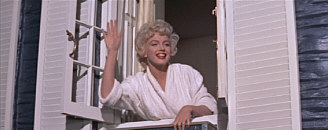 While it often shows its age, 1955’s The Seven Year Itch remains a generally charming and amusing look at attempted marital infidelity. The film endures in the public imagination due to its star, but even without Marilyn Monroe, it’d still offer a fairly entertaining experience. The DVD provides strong picture along with relatively clear sound and the best batch of supplements to accompany any of the discs in the “Diamond Collection”. The Seven Year Itch is a must-have for Monroe fans, and those who are curious about the Marilyn phenomenon may want to give it a look as well.
While it often shows its age, 1955’s The Seven Year Itch remains a generally charming and amusing look at attempted marital infidelity. The film endures in the public imagination due to its star, but even without Marilyn Monroe, it’d still offer a fairly entertaining experience. The DVD provides strong picture along with relatively clear sound and the best batch of supplements to accompany any of the discs in the “Diamond Collection”. The Seven Year Itch is a must-have for Monroe fans, and those who are curious about the Marilyn phenomenon may want to give it a look as well.
Note that The Seven Year Itch can be purchased on its own or as part of Fox’s Marilyn Monroe “Diamond Collection” set. The latter includes four other movies - How to Marry a Millionaire, There’s No Business Like Show Business, Bus Stop, and Gentlemen Prefer Blondes - plus a sixth DVD, a documentary called Marilyn Monroe: The Final Days. That disc only appears as part of “The Diamond Collection”, a package that’s really a steal for Monroe fans; in addition to the bonus DVD, it costs only $99.98 list as opposed to a total of $124.90 for the five films on their own. Granted, you’d need to really love Marilyn to want that much of her material, but if you fall into that category, it’s a great idea.